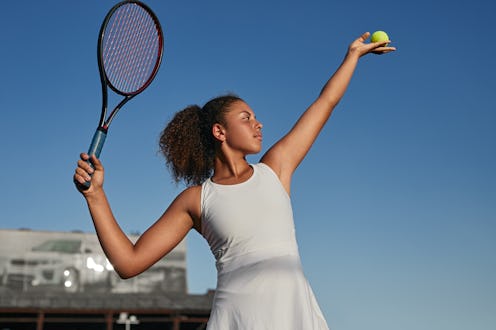Fitness
All The Muscles You Work When You Play Tennis
And it does this without feeling like a workout.

Just like pickleball, the classic sport of tennis has been making a comeback. It is, after all, a fun way to exercise without feeling like you’re exercising. And what’s even better is you don’t have to be a pro like Serena Williams to give it a try. As long as you can swing a racquet, chase after the ball, and hit a few volleys, you’ll be able to reap the strength and health-boosting benefits.
For one, tennis is a great way to get your cardio in, says Ajay Pant, the senior director of racquet sports at Life Time gyms. But what muscles does tennis work? Besides improving your flexibility, the racquet-based sport trains an assortment of muscles, too. It hones in on the larger muscle groups listed below (including the core and glutes), all thanks to the constant swinging and serving you do as you play. “In addition, it requires many short sprints and explosive movements, which will develop the fast-twitch muscle fibers necessary for athletic activity,” adds ACE-certified personal trainer TJ Mentus. And that means you’ll be quicker on your feet both on and off the court.
A key thing to keep in mind, especially if you’re playing tennis on a regular basis, is that tennis naturally uses one side of the body more than the other. According to Pant, you’ll quickly build up strength in your dominant arm — aka the one holding the racquet — which is why it helps to supplement your tennis game by strength training in other ways. He recommends doing a strength routine that targets the arms, legs, and core, playing other sports, and practicing yoga to ensure your non-dominant side gets attention, too. More on how tennis works your body, below.
All The Muscles Tennis Works
To make the most of your tennis game, Mentus recommends playing for a half-hour at least twice a week. Whether that means playing with a partner or hitting against a practice wall, these are the muscles that’ll get a major workout while you’re focused on getting that ball over the net.
Core
According to Nelo Phiri, a tennis coach at Life Time Westchester, the action of swinging a tennis racquet fires up your ab muscles. “Using your core in tennis is the ‘core’ of better control and balance when hitting your shots,” Phiri tells Bustle. You’ll feel it when serving, doing forehand or backhand swings, and whenever you make quick movements around the court.
Your core also engages as you swing, says Sandra Gail Frayna, a physical therapist with Hudson Premier Physical Therapy & Sports. While it may seem like a tennis swing comes from the arms, it’s actually a motion that engages your whole body, she tells Bustle, including the core.
Glutes
When watching a game, you’ll notice that tennis players are holding a squat pretty much throughout the entire game. “Squatting and staying low is often necessary for quick anticipation and explosiveness,” says Phiri. It’s this stance that enables you to change directions and sprint across the court. The glutes also light up as you swing to return the ball.
Quads
The quads — aka the muscles on the fronts of your thighs — get in on the action, too. “The quads have to work hard while playing tennis,” says Mentus. Again, this is thanks to the half-squat position that keeps the tension in your legs so you can spring into action. “They’re also required to accelerate and catch up to the ball,” he says.
Your quads are key for agility on the court, but also play a role in that swing, Frayna adds. You use the muscles of your lower body to twist into your swing to put more force behind the ball.
Shoulders
While there’s a lot of emphasis on your lower body and core in a game of tennis, “your upper body, arms, shoulders, and chest are key components, too,” says Frayna. “All aspects of your upper body are engaged when swinging in tennis.”
Forearms
It’s not every day you think about the forearm muscles, but they come in clutch when playing tennis. According to Mentus, these muscles are essential for gripping the racquet and striking the ball, making them a crucial component of an effective tennis swing.
“The forearm muscles are most important to grip strength and a stronger grip allows for more power to be exerted in the swing,” he explains. Work these muscles on and off the court and you’ll have Wimbledon-level tennis abilities in no time.
Sources:
Ajay Pant, senior director of racquet sports
TJ Mentus, ACE-certified personal trainer
Nelo Phiri, tennis coach
Sandra Gail Frayna, physical therapist
This article was originally published on